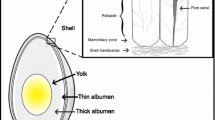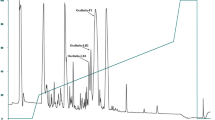Abstract
We report a putative defensive role for the precursors of Tyrian purple in the egg masses of the Australian muricid, Dicathais orbita. The fresh egg masses contain a high proportion of tyrindoleninone, which reacts to form tyriverdin and subsequently Tyrian purple and 6-bromoisatin as the eggs develop and the larvae hatch. Antimicrobial testing revealed that tyrindoleninone is toxic to both marine and human pathogens at a concentration of 1 mg/ml. Tyriverdin inhibits the growth of two marine pathogens, as well as the yeast Candida albicans at 0.001 mg/ml and was effectively bacteriostatic at 0.0005 mg/ml against three human pathogenic bacteria. Tyriverdin did not appear to significantly lyse the microbial cells. 6-Bromoisatin has mild antimicrobial properties, whereas Tyrian purple exhibited no significant activity. The antimicrobial properties of these compounds and changes in their presence during egg development correlates with ripening in the egg masses of D. orbita. This is the first report of the chemical ripening of eggs in a marine environment.
Similar content being viewed by others
REFERENCES
Baker, J. T. 1974. Tyrian purple: Ancient dye, a modern problem. Endeavour 33:11–17
Baker, J. T., and Duke, C. C. 1973. Chemistry of the indoleninones. II. Isolation from the hypobranchial glands of marine molluscs of 6-bromo-2,2-dimethylthioindolin-3-one and 6-bromo-2-methylthioindoleninone as alternative precursors to Tyrian purple. Aust. J. Chem 26:2153–2157
Baker, J. T., and Sutherland, M. D. 1968. Pigments of marine animals VIII. Precursors of 6,6′-dibromoindigotin (Tyrian purple) from the marine mollusc Dicathais orbita Gmelin. Tetrahedron Lett. No. 1:43–46
Bailey, K. C. 1929. The Elder Pliny's Chapters on Chemical Subjects, Part 1, Book 9. Edward Arnold, London
Blum, S., NOVAK, A., and Taber, S. 1959. Hydroxydecanoic acid, an antibiotic found in royal jelly Science 136:452–453
Chand, S., Lusunzi, I., Veal, D. A., Williams, L. R., and Karuso, P. 1995. Rapid screening of the antimicrobial activity of extracts and natural products. J. Antibiot. 47:1295–1304
Christophersen, C. 1983. Marine Indoles, pp. 259–285, in P. J. Scheuer (ed.). Marine Natural Products, Chemical and Biological Perspectives, Vol. V. Academic Press, New York
Christophersen, C., WÄtjen, Buchardt, O., and Anthoni, U. 1978. A revised structure of tyriverdin the precursor of Tyrian purple. Tetrahedron 34:2779–2781
Clark, R. J. H., and Cooksey, C. J. 1997. Bromoindirubins: The synthesis and properties of minor components of Tyrian purple and the composition of the colourant from Nucella lapillus. J Soc. Dyers Colourists 113:316–321
Cole, W. 1685. Letter to the Philosophical Society of Oxford containing observations on the purple fish. Phil. Trans. R. Soc. 15:1278
FriedlÄnder, P. 1909. Ueber den Farbstoff des antiken Purpura aus Murex brandaris. Ber. Deutsch Chem. Ges. 42:765–770
Fox, D. L. 1974. Biochromes. Occurrence, distribution and comparative biochemistry of prominent natural pigments in the marine environment, pp. 170–209, in D. C. Malins and J. R. Sargent (eds.). Biochemical and Biophysical Perspectives in Marine Biology, Vol. 1. Academic Press, New York
Gerlach, H. J. 1991. Manufacture of 2-nitrobromobenzaldehydes for the one-step manufacture of 6,6′-dibromoindigo. Ger Offen, DE 3,910,648, in Chem. Abstr. 114:75
Gil-Turnes, M. S., Hay, M. E., and Fenical, W. 1989. Symbiotic marine bacteria chemically defend crustacean embryos from a pathogenic fungus. Science 246:116–118
Hoffmann, R. 1990. Blue as the Sea. Am. Sci. 78:308–309
Kamiya, H., Muramoto, K., Goto, R., and Yamazaki, M. 1988. Characterisation of the antibacterial and antineoplastic glycoproteins in a sea hare Aplysia juliana. Nippon Suisan Gakkaishi (Bull. Jpn. Soc. Sci. Fish.) 54:773–777
Max, B. 1989. This and that on colour and catecholamines. Trends Pharmacol. Sci. 10:60–63
Muir, D. B. 1988. Preservation of fungi in sterile physiological saline. Aust. Microbiol. 9:358–359
Orians, G. H., and Janzen, D. H. 1974. Why are embryos so tasty? Am. Nat. 108:581–592
Paul, V. J., and Pennings, S. C. 1991. Diet-derived chemical defences in the sea hare Stylocheilus longicauda (Quoy et Gaimard, 1824). J. Exp. Mar. Ecol. Biol. 151:227–243
Paul, V. J., and Van Alstyne, K. L. 1988. The use of injected algal diterpenoids by Elysia halimeda Macnae (Opisthobranchia: Ascoglossa) as antipredator defences. J. Exp. Mar. Biol. Ecol 119:15–29
Pawlik, J. R., Kernan, M. R., Molinski, T. F., Harper, M. K., and Faulkner, D. J. 1988. Defensive chemicals of the Spanish dancer nudibranch Hexabranchus sanguinenus and its egg ribbons: macrolides derived from a sponge diet. J. Exp. Mar. Biol. Ecol. 119:99–109
Pechenik, J. A., Chang, S. C., and Lord, A. 1984. Encapsulated development of the marine prosobranch gastropod Nucella lapillus. Mar. Biol. 78:223–229
Peck, A. L. 1970. Aristotles′ Historia Animalium, Vol. 2. Harvard University Press, Cambridge, Massachusetts, pp. 145–151
Pinkney, J. M., and Chalmers, J. A. 1979. Synthesising Tyrian purple. Educ. Chem. 16:144–145
Prota, G. 1980. Nitrogenous pigments in marine invertebrates, pp. 141–178, in Paul J. Scheuer (ed.). Marine Natural Products: Chemical and Biological Perspectives, Vol. 3. Academic Press, New York
Voss, G., and Gerlach, H. 1989. Regioselektiver brom ?lithium-austausch bei 2,5-dibrom-1-nitrobenzol.—Eine einfache synthese von 4-brom-2-nitrobenzaldehyd und 6,6'-dibromoindigo Chem. Ber. 122:1199–1201
Ziderman, I. 1990. An exotic tale of shellfish, antiquity and prayer shawls: Tyrian and hyacinth purples. Trends Pharmacol. Sci. 11:60
Author information
Authors and Affiliations
Rights and permissions
About this article
Cite this article
Benkendorff, K., Bremner, J.B. & Davis, A.R. Tyrian Purple Precursors in the Egg Masses of the Australian Muricid, Dicathais orbita: A Possible Defensive Role. J Chem Ecol 26, 1037–1050 (2000). https://doi.org/10.1023/A:1005441116095
Issue Date:
DOI: https://doi.org/10.1023/A:1005441116095




